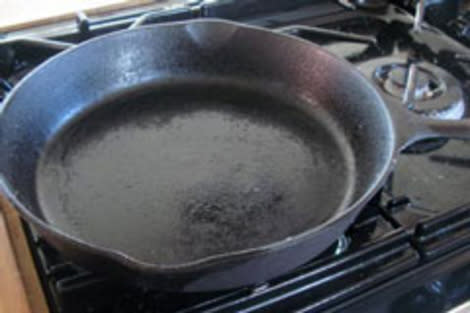Finding Cookware Gems Everywhere - Even in the Trash
Editor's note: Anne Mendelson may not fit your description of a dumpster-diver. She is a culinary historian and author of "Stand Facing the Stove," a biography of the authors of "The Joy of Cooking." But when it comes to unearthing kitchen gems, especially from the trash, she leads the parade. Cookbook author Nancy Harmon Jenkins joins in with tips for restoring cast-iron skillets.
By the Zester Daily staff
At 9:00 yesterday morning, I carried the garbage down the hall to the trash room in my apartment building. At 9:01, I was the owner of a new carbon-steel wok -- well, not new, but newly grabbed from the trash room floor where I'd found it wistfully gazing up at me. It was perfectly usable, though the wok was a trifle rusted and the lid had lost its wooden knob. A very little work with kosher salt and oil got rid of the first problem. The second was easily enough solved by threading a loop of butcher's twine through the hole and tying a few knots to keep the string from sliding.
Woks are far from my only specialty as snapper-up of unconsidered trifles. If every pot, bowl and kitchen tool I've ever bought vanished into thin air, I could still pull off a pretty good dinner with ones acquired otherwise. At least a third of my batterie de cuisine consists of found objects from someone else's kitchen.
A solemn reflection: What makes people toss these treasures?
My first gold strike occurred one day when I opened the trash-room door to find that someone had thrown away a large and beautiful clay poêlon. For those who have never encountered poêlons, they're a family of saucepans with long, straight handles made of various metals or heavy ceramics. I pegged it as one of the great pots from Vallauris in Provence, until the maker's mark leapt out at me: "Brown's Pottery, Arden, N.C." (A little digging revealed that the company once made excellent reproductions of Vallauris earthenware.) Ever since, the Pride of Arden has been my favorite baking dish. I use it for cassoulet, ratatouille, oven-braised sauerkraut, even baked beans. It was my luckiest find in a long career of helping myself to other people's discards.
* * *
Food Mills
I guess the phrase "food mill" doesn't convey much to most cooks under age 50 (or older). But when I was a kid, it was the pureéing implement of choice. Blenders existed, but our kitchen boasted no such refinements. Food processors weren't a gleam in even the most futuristic eye.
Tip 1: What material is the best for food mills?
If you wanted to turn cooked apples or tomatoes into applesauce or tomato sauce, you hauled out this bowl-shaped, tinned-steel device, plopped it over a slightly larger mixing bowl or pan, and cranked a handle that rotated an attached metal paddle against a perforated screen while also turning a sturdy spring-loaded wire scraper against the other side of the screen. The paddle forced the food through the bowl side of the screen, leaving skins and other refuse behind; the scraper cleaned the puree off the bottom into whatever receptacle you were using.
Tip 2: Where can you find classic food mills?
It's still one of my all-time favorite implements. The thing that sets food mills apart from nearly all other pureéing or grinding devices is the finished texture of the food. Mealy vegetables like potatoes or turnips end up satisfyingly smooth. Juicier fruits and vegetables keep just enough texture to avoid dullness.
-- Anne Mendelson
* * *
Restoring a Cast Iron Find
The best thing of all about black iron cookware, or a "spider" as some call it, is that it's so darned cheap. Often, when you're buying used cookware, it doesn't look at all promising, but it's usually fairly easy to restore even the most grotty looking iron pans. Here's one we found in the galley of a boat we bought a few years ago:
And here's what it looked like after I'd worked on it a couple of days:
And here's what I did: First I went over the pan, inside and out, with a soapy scrubbing pad (Brillo, I mean), then rinsed it all carefully and set it aside to dry. (Note that that was the last time the spider would ever see soap.) It still didn't look like much, but at least most of the rust had come off. I then tossed in a small handful of coarse salt and about a quarter cup of some old olive oil that had lost its punch and continued scrubbing with the salt and oil combination until the skillet was starting to look the way what I wanted. Again I rinsed it out -- no soap this time -- and dried it on a medium-hot burner. Finally, I heated the oven to 400 F, covered the bottom of the spider with a good film of olive oil, about ⅛-inch thick, set it in the preheated oven and simply left it for about 40 minutes -- or until I could no longer stand the odor of hot metal coming from the oven -- then turned the oven off and let the pan cool down. I wiped out the excess oil with paper towels and it was ready to go.
Tip 3: What's a perfect recipe for a cast-iron skillet?
I won't try to cook eggs in this spider until I've had a chance to season it further, which will happen as I continue to use it, but I've already done a vegetable mixture, searing the vegetables over high heat, then tossing them with lemon juice, and it was delicious.
-- Nancy Harmon Jenkins
* * *
Also fresh from Zester Daily, check out other indispensible kitchen tools:

